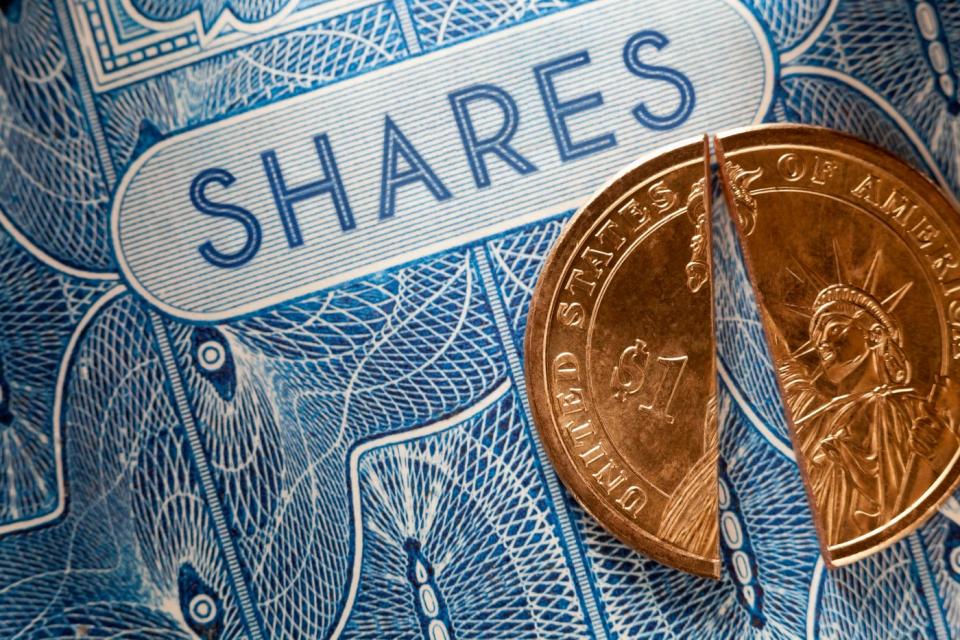It’s a rare time to be an investor on Wall Street. While it’s perfectly normal for a next-big-thing innovation, technology, or trend to be captivating investors’ attention, having two trends vying for interest at the same time doesn’t happen often.
Although artificial intelligence (AI) is the core catalyst that’s sent the iconic Dow Jones Industrial Average, broad-based S&P 500, and growth-focused Nasdaq Composite to record-closing highs in 2024, stock-split euphoria has played a key role, too.

A stock split is an event that allows a publicly traded company the opportunity to alter its share price and outstanding share count. What’s noteworthy about splits is that they’re entirely cosmetic, with a company’s market cap and operating performance being unaffected.
Stock splits come in two varieties, forward and reverse, with investors undeniably favoring the former. With a forward-stock split, a company is purposely lowering its share price to make it more nominally affordable for retail investors and/or its employees. Comparatively, the goal of a reverse-stock split is to increase a publicly traded company’s share price, often to ensure that it meets the minimum continued listing standards of a major stock exchange.
The reason investors favor forward splits is because they’re undertaken by highly innovative companies that consistently out-execute their peers.
Since 2024 began, around a dozen high-profile businesses have announced a stock split. However, none were more anticipated than that of AI titans Nvidia (NASDAQ: NVDA) and Broadcom (NASDAQ: AVGO).
Artificial intelligence leaders Nvidia and Broadcom became Wall Street’s newest stock-split stocks
Nvidia’s board kicked things off on May 22, with the company announcing a 10-for-1 forward split, which became effective after the closing bell on June 7. This marked the sixth stock split for Nvidia since going public in January 1999.
Not long after, on June 12, Broadcom’s board made history by announcing its first-ever stock split, which coincidentally was also of the 10-for-1 variety. Broadcom’s split went into effect after the close of trading on Friday, July 12, with shares trading at their split-adjusted price as of today, July 15.
While there’s natural excitement about a company’s stock being more nominally affordable for everyday investors, artificial intelligence has been the driving force for both companies.
Nvidia’s claim to fame is its first-mover advantages with AI-graphics processing units (GPUs). In 2023, 98% of the 3.85 million AI-GPUs that were shipped came from Nvidia, according to semiconductor analysis firm TechInsights. The company’s H100 GPU has become the go-to chip desired by businesses wanting to train large language models and run generative AI solutions.
What’s more, investors are excited about the future of Nvidia’s AI-GPU architecture. The company’s Blackwell platform, which offers accelerated computing improvements in a number of areas, including quantum computing and generative AI, is set to begin shipping to customers later this year. Meanwhile, in June, CEO Jensen Huang teased the release of the Rubin platform by 2026.
As for Broadcom, it’s quickly become the premier name in AI-driven networking solutions. It capitalized on the artificial intelligence hype last year by introducing its Jericho3-AI fabric in April 2023, which is able to connect up to 32,000 GPUs in AI-accelerated data centers. Jericho3 is a solution that’s designed to maximize the compute capacity of GPUs — something necessary for the split-second decision-making required of AI software and systems — as well as reduce tail latency.
Broadcom has also been a popular partner for some of the largest and most-influential tech companies, including infrastructure giant Dell Technologies and Alphabet, the parent company of internet search engine Google and cloud infrastructure service platform Google Cloud.

Broadcom can run circles around Nvidia over the next five years
Based on historical data from Bank of America Global Research that dates back to 1980, companies conducting forward-stock splits have averaged a 25.4% return in the 12 months following their announcement. This is more than double the average annual return of 11.9% for the benchmark S&P 500 over the comparable period. Statistically speaking, Nvidia and Broadcom would appear to be poised for more upside.
But dig beneath the surface and you’ll find a number of clear-cut reasons why Broadcom has the tools and intangibles to handily outperform Nvidia’s stock over the coming five years.
If there’s a prevailing theme that makes Broadcom the far more-favorable stock to own in the coming years, it’s history. Since the proliferation of the internet three decades ago, no next-big-thing innovation, technology, or trend has avoided a bubble-bursting event early in its existence. This is a roundabout way of saying that investors consistently overestimate the utility and/or adoption of new innovations and technologies, and artificial intelligence is unlikely to be the exception to this unwritten rule.
The entirety of Nvidia’s nearly $3 trillion increase in market value since the start of 2023 has come on the heels of its AI-GPUs and CUDA platform, which is a toolkit that helps developers build large language models. If the AI bubble were to burst at some point in the future, Nvidia’s stock would probably be clobbered more than any other AI company.
Although Broadcom has also enjoyed a sizable boost from AI, it’s a considerably more-diversified company that would fare better if history were to rhyme. For example, Broadcom generates a notable percentage of its sales from wireless chips and accessories used in next-generation smartphones. It also makes optical components used in industrial equipment, networking solutions for newer automobiles, and cybersecurity solutions, to name a small number of its other ventures and sales channels. Whereas the bursting of the AI bubble would be damning for Nvidia, it wouldn’t be an end-all for Broadcom.
Something else to consider is that Broadcom’s rapidly growing dividend provides a safer foundation and, arguably, more mature investor base than Nvidia. Even with Nvidia recently increasing its quarterly payout by 150% to $0.01 per share on a post-split basis, the company’s token yield is only 0.03%.
Comparatively, Broadcom’s quarterly payout has catapulted higher by 7,400% since late 2010. Whereas the company had previously been pacing a $0.28 base annual payout, Broadcom is now on track to dole out a cumulative $21/share annually to its investors. This is good enough for a 1.2% yield, and it demonstrates how consistent Broadcom’s growth in operating cash flow has been since the end of the Great Recession.
The final reason Broadcom can handily outperform Nvidia in the return column over the next five years is their respective valuations. Nvidia’s trailing-12-month (TTM) price to sales (P/S) ratio recently topped 40. This effectively matches the TTM P/S peaks witnessed prior to the dot-com bubble bursting from the likes of Amazon and Cisco Systems.
Although Broadcom’s TTM P/S ratio of 19 is considerably higher than its average of 5 to 7 times sales over much of the last decade, it’ll have a much easier time growing into its current valuation than Nvidia.
Between Wall Street’s two premier stock-split stocks, Broadcom looks to be a smarter long-term investment than Nvidia.
Should you invest $1,000 in Nvidia right now?
Before you buy stock in Nvidia, consider this:
The Motley Fool Stock Advisor analyst team just identified what they believe are the 10 best stocks for investors to buy now… and Nvidia wasn’t one of them. The 10 stocks that made the cut could produce monster returns in the coming years.
Consider when Nvidia made this list on April 15, 2005… if you invested $1,000 at the time of our recommendation, you’d have $791,929!*
Stock Advisor provides investors with an easy-to-follow blueprint for success, including guidance on building a portfolio, regular updates from analysts, and two new stock picks each month. The Stock Advisor service has more than quadrupled the return of S&P 500 since 2002*.
*Stock Advisor returns as of July 8, 2024
John Mackey, former CEO of Whole Foods Market, an Amazon subsidiary, is a member of The Motley Fool’s board of directors. Suzanne Frey, an executive at Alphabet, is a member of The Motley Fool’s board of directors. Bank of America is an advertising partner of The Ascent, a Motley Fool company. Sean Williams has positions in Alphabet, Amazon, and Bank of America. The Motley Fool has positions in and recommends Alphabet, Amazon, Bank of America, Cisco Systems, and Nvidia. The Motley Fool recommends Broadcom. The Motley Fool has a disclosure policy.
Nvidia and Broadcom Have Completed Their 10-for-1 Stock Splits, but Their Outlooks Differ Dramatically Over the Next 5 Years was originally published by The Motley Fool
Source: finance.yahoo.com

